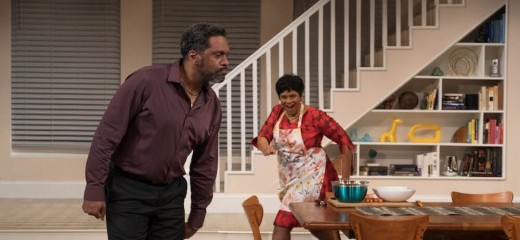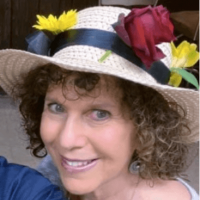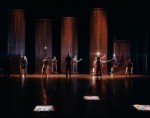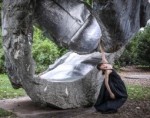
In Fairview, It’s All About Perspective
by Darcy Grabenstein
For a play that’s not a musical, dance plays a big part in the first act of Jackie Sibblies Drury’s Pulitzer Prize-winning Fairview. In the opening scene at The Wilma Theater, mother Beverly (played by Melanye Finister) dances her way from the kitchen to the living room. The radio blares soul music and she’s shimmying like no one is watching as she prepares a birthday meal for her mother, Mama.
Beverly jumps in surprise when, unbeknownst to her, husband Dayton (played by Lindsay Smiling) enters the room and spies her bopping around. “You don’t just watch a person!” she chides him, alluding to the play’s theme of being watched. He joins in with some suave moves of his own. The dancing continues a few scenes later when the family spontaneously breaks out into a choreographed birthday dance that’s just shy of the oft-dreaded chicken dance.
One by one, the family members make their appearance in the Frasier home. There’s Beverly’s sister, the fun-loving Aunt Jasmine (played by Jaylene Clark Owens); Keisha, the Frasiers’ teenage daughter (played by Brett Ashley Robinson); Mama, the matriarch of the family; and uncle Tyrone (played by Matteo Scammel) who, like Mama (played by MK Tuomanen), makes a grand entrance but does so with awkward, jerky dance moves. The Frasiers are portrayed as a middle-class Black family. But are they really what they appear to be?
While I had read that some people walked out on other productions of the play, perhaps because they were offended by the content—or, as I would guess, because it revealed hard truths about American racial dynamics—the bizarreness of it all had me glued to my seat to the end.
In one scene, Beverly and Jasmine are arguing, and Beverly shuffles her feet toward Jasmine, arm outstretched like a fencer, and her movement matches their verbal sparring. In another scene, there’s a food fight; with fake food, slow-motion moves, and flashing lights, the scene is surreal. The brilliant staging was courtesy of director James Ijames.
In the second act, the front of the stage is darkened and the Frasier family pantomimes the entire first act all over again, scene for scene, movement for movement. It gave me a strange sense of déjà vu. Meanwhile, blinds on the large windows in the family room have been opened, and we see and hear four white people who, based on their dialogue (“race is a construct”), come across as ostensibly liberal. Yet it’s as if the white folks are talking over their Black counterparts, creating an art-imitates-life vibe of white people talking, not listening, when it comes to discussions about racial prejudice.
The family’s name seems to reference the TV series Frasier, a '90s sitcom featuring a middle-class family and set largely in their light, comfortable home. Like the show and many other sitcoms of the era, the first act of Fairview employed both verbal and physical humor that had many in the audience laughing out loud. I was bothered by the fact that, as a white person, I thoroughly enjoyed the first act. Was it because the Frasier family seemed to resemble comfortable and familiar sitcom tropes, even as members were depicted with subtle (or maybe not so subtle) stereotypes? Or did I enjoy it in spite of that?
I felt that many microaggressions experienced by Black people were depicted in the second act. This seemed to simulate how microaggressions accumulate into the oppressive reality that many Black people confront daily. At first, I wondered if my sense of overwhelm as an audience member reflected how the play might alienate audiences and detract from its message. However, I now believe this immense sense of overwhelm means that the playwright hit their mark.
The final scene of Fairview contains a significant shift. Keisha asks the white audience members to switch places with the Black actors on stage, as if asking them to switch places in society, even for only a few minutes. Keisha becomes choreographer, instructing people to take their places on stage. She asks them to come “to where I’ve always been, where my family has always been. ... Look out from where I am. And let me and my family go out to where you’ve always been.” Keisha does not dance around the issue; she tackles it head-on.
Because I was busy taking notes, I remained in my seat. This made me a bit uncomfortable; I was afraid of being perceived as someone who supported the concept of racism, both overt and subtle. In keeping with the play’s theme, I feared being viewed unfavorably. However, I don’t think those in the audience even noticed my presence. I had the privilege of going unnoticed, appearing to "belong"--unlike Black audiences, who have historically been excluded from theaters. Based on the “mmmm-hmmms” and nods from those in their seats, it appeared that many understood and agreed with the message in Keisha’s monologue.
The play’s name says a lot about the play itself. In the play, as in society, Black individuals often are subject to unfair views. The play makes me, as a white person, think hard about the lack of fairness in the Black experience. At first, I would have preferred that the characters continued to develop, and that their dialogue would have hammered home the play’s message. I thought a more familiar format such as this would have been more effective. However, the fact that the playwright mixed up the format truly got the audience’s attention.
This role reversal prompted audience members to view the play from a different perspective, and to listen. In the last scene, Keisha’s dialogue is directed at Suze, one of the white characters from Act Two, but I felt her words were directed at me, at all white people. She summed it up in just a few words: “I’ve been trying to talk to You. This whole time.”
Fairview by Jackie Sibblies Drury, Wilma Theater, May 31–June 26
By Darcy Grabenstein
August 16, 2022








